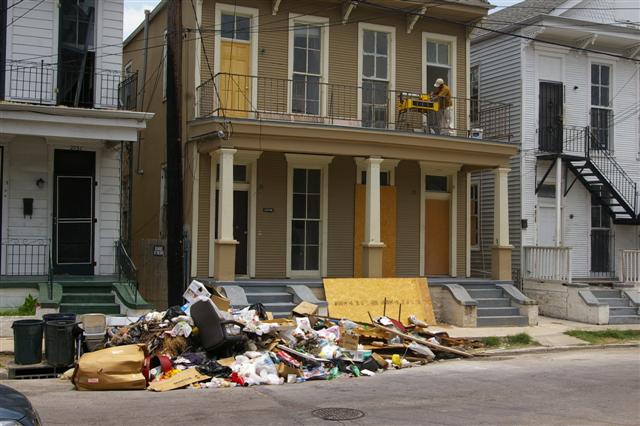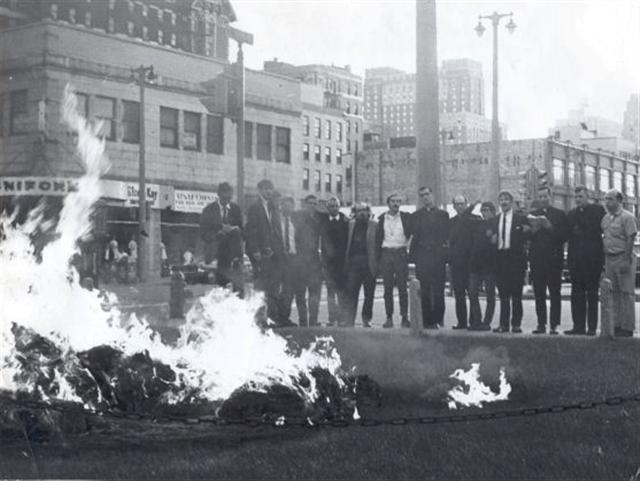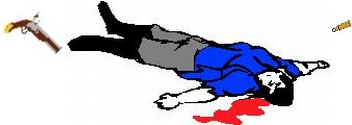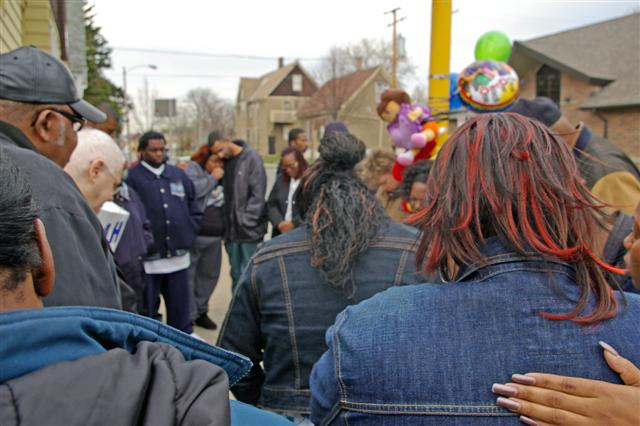Easter Sunday 2007

New Orleans
8 months after KatrinaMilwaukee is my home, dear to me. It is the city of festivals, family and friends, the home of Growing Power and the Milwaukee Renaissance. Milwaukee has been called a “small town”, where everyone knows everyone. It is still home to Friday night Fish fries and homemade frozen custard. However, underneath the ‘sweet waters’ of Milwaukee runs a deep current of discrimination. This is not overt discrimination but a very structured, systematic form that is so prevalent that it is hard for us living in it to see and feel it.
Milwaukee is not the only place where structural discrimination exists. It pervades our American Society. However, except in a crisis like Hurricane Katrina in New Orleans it is hard to point to. In Milwaukee, being a city with a “small town” feels structural discrimination seems to stand out more.
A good way to see understand this phenomena of being able to see structural discrimination in Milwaukee clearer is to look at the past. For example, in the 60′s civil rights struggle there were many marches for racial equality. However, when a white Catholic priest marched with African Americans from the north side across the 16th street viaduct for an open housing law he and others were met with stones and angry words by the “all white” south side residents.
Also in 60s there was civil rights and peace movements in many major universities. However, when a few students at a Catholic Jesuit University in Milwaukee, Marquette, protested the “institutional racism” of the university, the structural ways that kept out African American’s, except for basketball players, it led to a major protest. In one day the university said no to all the demands of the students to open the university, the basketball team resigned and was brought back, the small number of other black students resigned from the university and eventually came back, students were arrested for a peaceful sit down in the union and expelled and eventual reinstated from the university. Although the next year Marquette started an Educational Opportunity Program” opening up the University to an integrated population Marquette never acknowledged that it was discriminating.

Milwaukee 14In the 1968 I was part of the Milwaukee 14, a burning of draft records in a nonviolent protest. There were many of these types of actions around the USA but none, except the first one the Catonsville Nine, became such a major event in the city. It was a sword of division and I remembered we, like Father Groppi, were either loved or hated by everyone. There was no in between.
These events were big in Milwaukee because they were polarizing actions. They had a major impact because they were covered well in the media and recognized by city officials. Marquette administrators or supporters of the war really reenacted. Changes came, an open housing law was past eventually, Marquette opened up the university the following year and the peace movement became strong gin Milwaukee and eventually the war ended.
Things changed on one level but the deep structural discrimination continued. However, it took on a new form on the side of the “powers to be.” They learned how not to react to protest or nonviolent actions, usually just ignoring them. Another things learned is how to divide and conquer the opposition. Some leaders become the “in” people and some are just labeled and marginalized.
Here are some modern day examples of structural discrimination and how city officials and the media now deal with the issues.
Discrimination of where you can live continues in Milwaukee but now it is not as overt. There has been the normal amount of “white flight” from the city but those left behind are still limited in where they live. One of the most effective ways the city now discriminates against who lives in what neighborhood is by way of City and Building Ordinances and the Board of Zoning Appeals (BOZA).
For example, some seven or more years ago, a mental health clinic serving poor persons with a major mental illness, due to overcrowding, wanted to move it’s day mental health clinic 27 blocks west on Wisconsin Avenue, from a location on the Marquette University Campus (MU) to a larger facility near Marquette High School, that like MU, also run by the Jesuits. The neighborhood groups and city officials could not stop the operators of the clinic from purchasing the new building but the health clinic would need a “special use permit” from BOZA to occupy the new site.
The local aldermen, neighborhood groups, the Jesuit High school bitterly fought the relocation of the clinic. They called persons with a mental illnesses all kids of names, “criminals”, self induced drug addicts and said publicly how if the persons at the clinic would “destroy the neighborhood.” Although they had no evidence to back their statements the BOZA twice refused the “special use permit” until finally a Federal Court ruled that the City had “disciminated” against the clinic in violation of the American Disability acts. Eventually the clinic moved into the new location and there have been no hassles. Marquette High, a major opponent of the clinic, has even started to send their youth to the clinic service work.
You would think the story would end there, but the City could not accept the fact that it had “discriminated” against the poor and ill and appealed the Federal Ruling to the Federal Circuit Court. They just won a favorable ruling based on the technicality so the case is now back again in the local Federal court. City monies are being use to enforce discrimination.
Now this clinic has enough support and finances to battle the city on this act of discrimination. There are many other examples of “zoning people out of neighborhoods” where the poor, outcast and their advocates did not have the money and ability to hire such good lawyers and have very quietly being zoned out.
At Marquette the Jesuit University that opened is door to minority students in the 60s the structural discrimination goes on. Women professor to do not make the same pay or get the same positions as their male counter parts. Marquette brags about its “Jesuit Catholic Values” but host military ROTC programs, whose curriculum are not subjected to university scrutiny. The program teaches that “Army values”, that directly contradict “Jesuit Catholic Values” are superior. When an individual or a group tries to say something about this hypocracsy they are “ignored” or marginalized quickly. Marquette students go with the university’s okay to march on the School of America to protest the teaching of “army values” to soldiers from South American who violently suppress human rights and have tortured and killed persons, including a number of religious and Jesuit priest. However, when the same “values” which contradict Catholic values are taught on campus they are just ignored.
Marquette administrators have learned how to not react against those who point out their hypocrisy on what they teach and what they do. If someone speaks out too loudly they just marginalized the person. In fact presently students protesting the School of Americas are receiving advice from the same administrators that promote the teaching of ‘army values’ over “Christian values. They are “in” with the university as long that they do not connect SOA teachings with ROTC teachings on values.
This structural discrimination is more easily seen in the violent crime rate predominately in the African American community which still predominately lives on the north side where the civil right marches for open housing in the 60s initiated.

Milwaukee homicide rate is climbing. This year the homicide rate is 40 persons who count all homicide. The city who does not count justified homicides by police officers, homicides by use of car, like drunk driving, and various other ones still has an official count of 31 or 32 since Jan. 1st. Since the violence is amidst African Americans politicians largely ignore it in the media. There is usually a line or two hid away in the metro section saying someone, usually no name is given, and of a certain age was “shot and killed” at a particular location. For a small group of us that have prayer vigils for a all homicide victims (see memorial for all victims at) we know this means it was a black person killed. However, if a white person is killed in this same area, like there was a few weeks ago, there will be a major story in the paper about it, memorializing the victim with many follow-ups on the investigation. The person was not only named but was honored.
I thought this was great and have been encouraging the newspaper to do the same for all victims of these senseless killings. However, when the next day I heard that a 16-year youth was killed in his own front yard I scarred the paper for a mention. On the front of the metro section of the paper the next day I did find an article about a 16 African American Youth, but it was an article about a 16 year old accused of killing the white man? Hidden away in the metro section were a few lines about a nameless 16 year old that were killed in his front yard. It mentioned some persons driving by killed him that he had exchanged words with the implication that they had exchanged insults. Interestedly some witnesses at the white persons killing said he exchanged words with his killer but the media implied that probably the white person was trying to talk the young black man for destroying his own life.
There are many other examples of this type of depersonalized coverage of homicide victims. However, I call it discrimination rather than racism, because the more common denominator than race is poverty, status in the community and who you are. There was a white youth recently shot in an African American who went nameless in the paper with the assumption that he was involved in something illegal.
Some years ago I made a search for the most marginalized outcast person in our society. Outside of a sex offender, especially pedophile persons, the lowest person I could found was a poor person with a mental illness, young, black with any criminal record, no matter how small.
Recently the Milwaukee Journal Sentinel, our hometown newspaper that practices institutional discrimination all the time, wrote a front page series about a white special agent for the state Department of Justice Division of Criminal Investigation that who was killed stopping at a gas station to pick up a cup of coffee around midnight in the summer of 2004. For the story they interviewed the young African American man who shot the officer. He is now serving a 117-year prison term. This young man with others had been involved in a series of armed robberies. This quote from him in the paper is telling of how the mind of these young men works. He says: “Everyone we robbed was our own people, black people. I got this thing: I don’t mess with them (white people), and they don’t mess with me. I mess with people who I know I can pull it and get away it with. Mess with the other people, they gonna send them people at us.”

Prayer Vigil for Milwaukee’s 40th homicide victimThis morning, April 17th, I attended a prayer vigil for a young man who was shot and killed Saturday night. I missed the nameless notice of his death in last Sunday’s paper because it was not in the “local briefing” but mentioned in an article on “cruising” and some shootings. He was still nameless and it is unclear if his death was even related to ‘cruising’. His family seems to think he was shot in a robbery attempt. No one knows how he died. However, the family really cared about this young man and turned out in big numbers for his street side prayer vigil. After the vigil I talked with some of his brothers, one of them a twin brother. They just described him as a young man who worked hard and just enjoyed a good time hanging with friends on weekends. Like at all the prayer vigils I wanted to know more about this young man, who he was, how he was loved by family and friends. However, his death as most of the other 39 homicide victims will be ignored by most. “They just do not want to know”, one young man said to me today at the vigil.
In conclusion, when I was a young minister my mantra to adults about youth is that youth learn more from you do than what you say or peach to them. I have met youth who vehemently deny they are like their parents but hold the same core values. Youth learn more about what is valuable by the structural environment than they do by any words you say to them. For example, parents and people would always tell them how important it is to learn and experience your faith. However, they only had to go to religious education class a few times a month for about six months of the year and most of the religious services they attended were boring and did not relate to their daily lives. The structure spoke volumes to them about the meaning of their faith.
Taking the words of the young man in prison for his life and the treatment by society and media of the young man killed last Saturday, what lessons in life is our structure teaching us about the value of life?
The war in Iraq, the terrible tragedy yesterday at Virginia Tech, the treatment of homicides in Milwaukee, the local newspaper, the local city ordinances, the teaching of “army values” on a Christian campuses, the proliferation and availability of hand guns, how we treat the poor, homeless and ill are teaching us everyday. When will we wake up to this structural discrimination and resulting nightmare of violence? When we do, it will stop. Only than can we really enjoy the “sweet waters” of Milwaukee.